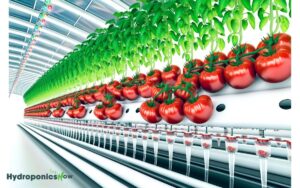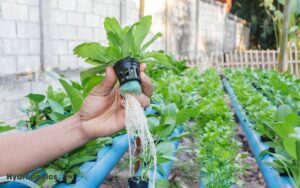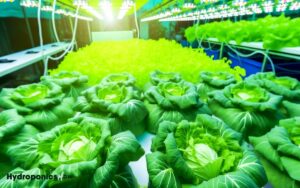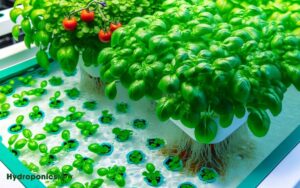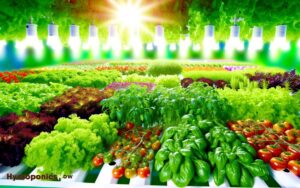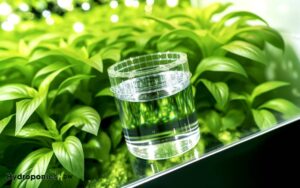Different Types of Hydroponic Weed: 5 Optimal Choices
Hydroponic weed cultivation encompasses various sophisticated systems tailored for best growth.
- Deep Water Culture immerses roots in oxygenated nutrient solutions, preventing hypoxia.
- Nutrient Film Technique provides a thin, constant nutrient flow over roots.
- Ebb and Flow cycles nutrient-rich water to prevent deficiencies and diseases.
- Drip Systems deliver precise nutrients directly to the roots.
- The Wick System leverages capillary action for low-maintenance hydration, while Aeroponics uses mist for enhanced oxygenation and nutrient uptake.
Advanced setups like Fogponics and Hybrid Systems offer further enhancements for efficiency and plant health. Understanding these diverse systems can greatly elevate cultivation efficacy. Explore further insights for top application.
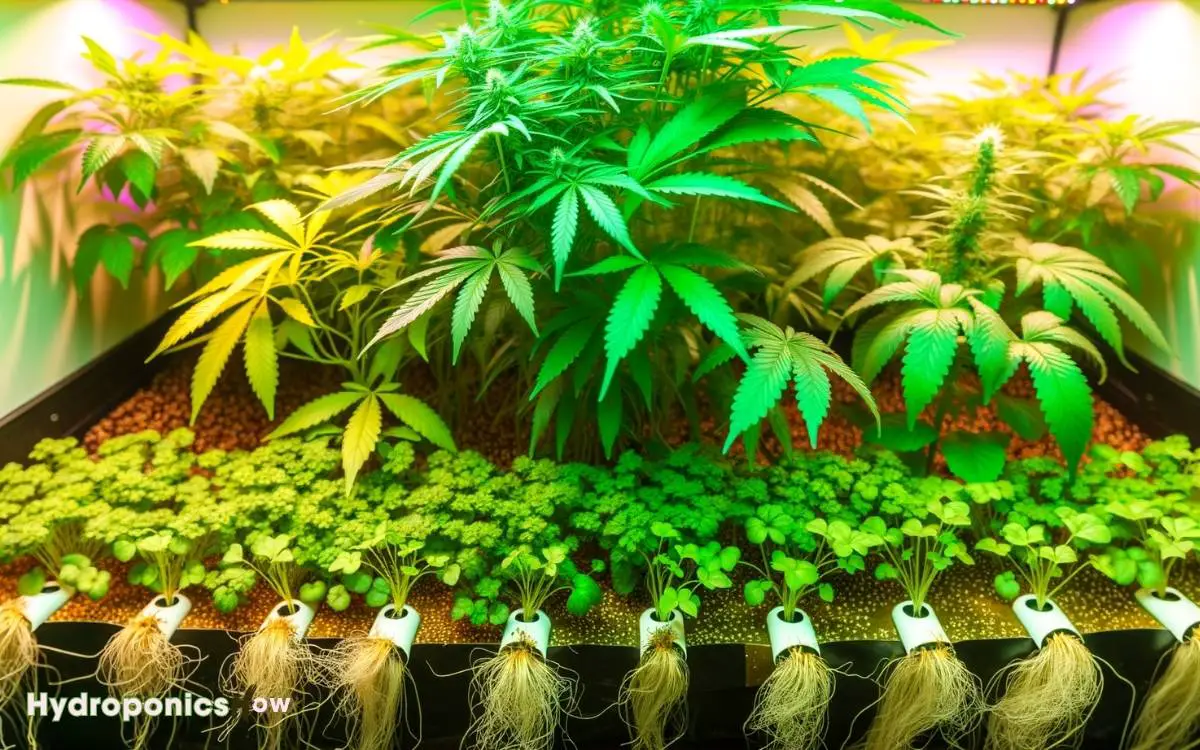
Key Takeaways
Deep Water Culture
Deep Water Culture (DWC) is a hydroponic system wherein plant roots are suspended in a nutrient-rich, oxygenated water solution, providing direct access to essential minerals and oxygen.
This method employs air pumps to guarantee continuous oxygenation, preventing root hypoxia and promoting robust growth.
The absence of soil mitigates risks associated with soil-borne pathogens, enhancing plant health. DWC setups typically use net pots to support the plants, allowing roots to extend freely into the solution.
The constant availability of nutrients accelerates growth rates and increases yields.
Monitoring and adjusting pH, Electrical Conductivity (EC), and Dissolved Oxygen (DO) levels are critical for maintaining ideal conditions. This system offers a high-efficiency, low-maintenance approach ideal for both novice and experienced cultivators.
Nutrient Film Technique
The Nutrient Film Technique (NFT) utilizes a thin, continuous flow of nutrient-rich solution to deliver essential minerals directly to the plant roots, promoting maximum absorption and growth.
This method guarantees that the roots are consistently exposed to oxygen, enhancing root health and preventing common issues such as root rot.
Additionally, NFT systems are highly space-efficient, making them ideal for both small-scale and commercial hydroponic operations.
Constant Nutrient Flow
Nutrient Film Technique (NFT) is a hydroponic system that delivers a continuous, thin film of nutrient-rich water over the plant roots, ensuring ideal nutrient absorption and oxygenation.
This method uses a slight tilt in the growing channels to facilitate the constant flow of the nutrient solution, which prevents stagnation and enhances nutrient delivery.
| Component | Function | Description |
|---|---|---|
| Growing Channels | Plant Support | Holds plants, sloped for nutrient flow |
| Nutrient Solution | Nutrient Supply | Water mixed with essential nutrients |
| Reservoir | Nutrient Storage | Stores and recirculates the nutrient solution |
| Pump | Solution Circulation | Moves nutrient solution through the system |
NFT is particularly effective for leafy greens and herbs, providing an optimized growth environment by maintaining a balanced nutrient and oxygen supply at the root level.
Root Health Benefits
Given the continuous flow of nutrient-rich water, the Nutrient Film Technique (NFT) greatly enhances root health by preventing waterlogging and ensuring ideal oxygenation.
This method employs a thin film of nutrient solution that flows over the plant roots, facilitating best nutrient uptake while avoiding stagnant conditions that can lead to root rot.
Additionally, the constant movement of the solution helps maintain a high level of dissolved oxygen, crucial for cellular respiration and root vitality.
The dynamic environment created by NFT promotes robust root development, characterized by increased root hair density and length, which further improves nutrient absorption efficiency.
Consequently, plants grown using NFT exhibit accelerated growth rates, enhanced disease resistance, and overall superior health compared to traditional soil-based cultivation.
Space Efficiency
Among the various hydroponic methods, the Nutrient Film Technique (NFT) is particularly noted for its exceptional space efficiency, allowing for higher plant density and efficient use of limited cultivation areas.
This method involves a thin film of nutrient-rich water flowing continuously over the roots of plants, which optimizes nutrient uptake and oxygenation.
The NFT system is characterized by:
- Vertical Stacking: Utilizing vertical space by stacking multiple growth channels, maximizing plant yield per square meter.
- Compact Design: Minimizing the footprint of the system, making it ideal for urban or confined spaces.
- Scalability: Easily scalable by adding more channels or layers without compromising system integrity.
- Root Zone Aeration: Ensuring ideal oxygen levels at the root zone, enhancing plant health and growth.
This approach is pivotal for maximizing space utilization in hydroponic weed cultivation.
Aeroponics
Aeroponics represents an advanced hydroponic system where plant roots are suspended in air and periodically misted with nutrient-rich solutions, ensuring ideal nutrient uptake.
This method enhances the oxygenation of the root zone, thereby promoting accelerated growth rates and robust plant health.
Additionally, the aeroponic environment minimizes pathogen proliferation, resulting in superior disease control efficiency compared to traditional hydroponic systems.
Root Mist Nutrient Delivery
Root mist nutrient delivery, also known as aeroponics, involves suspending plant roots in an air chamber and intermittently misting them with a nutrient-rich solution, facilitating ideal oxygenation and nutrient uptake.
This method enhances growth efficiency and minimizes water usage by guaranteeing direct nutrient absorption.
The key advantages of aeroponics include:
- Maximized Oxygenation: Roots receive peak oxygen levels, promoting faster and healthier growth.
- Efficient Nutrient Use: Direct misting reduces waste and guarantees precise nutrient delivery.
- Water Conservation: Uses much less water compared to traditional soil methods.
- Disease Prevention: Reduced risk of soil-borne pathogens due to the absence of a growing medium.
Aeroponics is a sophisticated technique that optimizes plant health and growth efficiency through precise environmental control.
Oxygen-Rich Growth Environment
Creating an oxygen-rich growth environment in aeroponics is essential for maximizing plant metabolic functions and ensuring robust development.
Aeroponics systems achieve this by suspending plant roots in air and intermittently misting them with a nutrient-rich solution.
This method greatly enhances oxygen availability to the root zone, promoting efficient nutrient uptake and accelerating growth.
The elevated oxygen levels optimize cellular respiration processes, thereby increasing the production of adenosine triphosphate (ATP), which is vital for energy transfer within cells.
Additionally, the absence of a traditional growing medium reduces the risk of root suffocation and encourages more extensive root hair development, further enhancing nutrient absorption.
This optimized oxygenation environment is crucial for achieving superior plant vigor and yield in hydroponic cultivation.
Disease Control Efficiency
Disease control efficiency in aeroponics is markedly enhanced by the system’s ability to minimize pathogen exposure through the absence of soil-borne contaminants.
The closed-loop nature of aeroponic systems guarantees a controlled environment, greatly reducing the risk of disease propagation.
Key factors include:
- Sterile Growing Medium: Utilizes air or mist, eliminating soil-borne pathogens.
- Efficient Nutrient Delivery: Nutrient solutions are continuously monitored, maintaining ideal pH and nutrient levels.
- Improved Air Circulation: Enhances plant respiratory functions, limiting fungal and bacterial growth.
- Isolated Root Systems: Prevents cross-contamination between plants, reducing the spread of diseases.
These features collectively contribute to the robust disease control capabilities of aeroponic systems, thereby promoting healthier plant growth and higher yields.
Wick System
The wick system is one of the simplest forms of hydroponic cultivation. It relies on a passive capillary action to deliver nutrient solutions to the plant roots.
This system incorporates wicks, typically made from absorbent materials such as cotton or nylon, extending from the nutrient reservoir to the root zone.
As the plant absorbs nutrients, the capillary action guarantees a continuous supply of water and dissolved minerals. This method is suitable for smaller plants with low water and nutrient demands.
The wick system’s simplicity and lack of moving parts reduce the likelihood of mechanical failure, making it ideal for beginners.
However, it may not be effective for larger plants or those with higher nutrient requirements due to limited nutrient transport capacity.
Ebb and Flow
Unlike the passive nature of the wick system, the ebb and flow method employs an active approach to nutrient delivery by periodically flooding the plant roots with nutrient solution and then allowing it to drain back into the reservoir.
This dynamic system guarantees ideal nutrient uptake and oxygenation, promoting robust plant growth.
Key components include:
- Flood Table: A tray where plants are placed, designed to hold the nutrient solution temporarily.
- Reservoir: Stores the nutrient solution, typically located beneath the flood table.
- Pump: Actively transports the nutrient solution from the reservoir to the flood table.
- Timer: Regulates the flood and drain cycles to maintain consistent nutrient supply.
These elements work cohesively to sustain a balanced environment, preventing nutrient deficiencies and root diseases.
Drip System
A drip system delivers nutrient solution directly to the plant roots via a network of tubes, emitters, and control valves, guaranteeing precise and consistent nourishment.
This hydroponic method utilizes emitters to release a controlled amount of nutrient solution, minimizing waste and promoting ideal growth conditions.
The system’s effectiveness hinges on proper calibration and maintenance of the emitters to prevent clogging and ensure uniform distribution.
The drip system can be configured as either recovery or non-recovery: in recovery systems, excess solution is collected and reused, whereas in non-recovery systems, it is discarded.
This flexibility makes the drip system highly adaptable for various scale operations, from small-scale personal gardens to large commercial setups, offering precise control over nutrient delivery.
Kratky Method
The Kratky Method offers a straightforward setup process, requiring minimal equipment, which makes it particularly accessible for cultivators.
This method eschews the use of air pumps, relying instead on the natural air gap created as plants consume the nutrient solution.
Effective management of the nutrient solution’s levels and composition is crucial to guarantee the best plant growth and health.
Simple Setup Process
Leveraging the Kratky Method for hydroponic weed cultivation involves a straightforward setup process that requires minimal equipment and maintenance. This method is particularly suitable for home growers due to its simplicity and cost-effectiveness.
The following steps outline the basic setup:
- Container Selection: Choose a non-transparent container to prevent algae growth.
- Nutrient Solution: Fill the container with a nutrient-rich water solution, ensuring the correct pH and nutrient concentrations.
- Plant Support: Utilize net pots and a medium like rock wool to hold the cannabis plants.
- Water Level Management: Initially, submerge the roots in the solution, then allow the water level to decrease gradually, promoting root oxygenation.
This uncomplicated method allows for efficient and effective hydroponic weed cultivation.
No Air Pumps
Kratky’s method eliminates the need for air pumps by relying on a passive oxygenation process, where the gradually decreasing water level creates an air gap that allows roots to access oxygen directly.
This method is lauded for its simplicity and efficiency, particularly in small-scale or hobbyist operations.
| Feature | Description | Benefits |
|---|---|---|
| Passive System | No mechanical parts needed | Reduced maintenance |
| Air Gap Creation | Water level decreases over time | Roots receive oxygen naturally |
| Cost-Effective | Eliminates need for air pumps and electricity | Lower operational costs |
| Scalability | Ideal for small to medium setups | Flexible application |
| Simplicity | Minimal intervention required | User-friendly |
Kratky’s method is particularly advantageous for beginners due to its low complexity and operational costs. The air gap guarantees adequate root oxygenation without the need for continuous monitoring.
Nutrient Solution Management
Effectively managing the nutrient solution in the Kratky method involves accurately balancing pH levels, nutrient concentration, and water quality to guarantee ideal plant growth.
This passive hydroponic system requires meticulous attention to the following critical factors:
- pH Levels: Maintain a pH range between 5.5 and 6.5 to ensure the best nutrient uptake.
- Nutrient Concentration: Use a balanced nutrient mix, checking electrical conductivity (EC) to stay within 1.2 to 2.4 mS/cm.
- Water Quality: Utilize dechlorinated or distilled water to prevent harmful chemical interactions.
- Nutrient Solution Renewal: Change the nutrient solution every two weeks for the most favorable plant growth and to prevent nutrient imbalances and pathogen buildup.
Vertical Hydroponics
Vertical hydroponics is a method that maximizes space efficiency by growing plants in vertically stacked layers. It offers a sustainable solution for cultivating weed in urban environments.
This approach employs modular systems, utilizing columns or towers to house multiple plant sites, each receiving a calibrated supply of nutrient-enriched water.
Efficient use of vertical space not only enhances yield per square meter but also reduces the footprint required for cultivation.
Key components include LED lighting systems tailored for each growth stage and automated irrigation systems to maintain the most suitable nutrient delivery. This method minimizes water usage and maximizes light exposure, fostering robust plant development.
Vertical hydroponics seamlessly integrates with urban settings, providing a viable option for high-density weed production.
Aquaponics
Aquaponics, a synergistic integration of aquaculture and hydroponics, leverages the natural biological cycles of fish and plants to create a self-sustaining ecosystem for cannabis cultivation.
This system utilizes fish waste as a nutrient source, which is broken down by nitrifying bacteria into accessible forms for the plants.
The plants, in turn, filter and purify the water, maintaining an ideal environment for the fish.
Key benefits of aquaponics include:
- Nutrient Efficiency: Fish waste provides a rich nutrient source for cannabis.
- Water Conservation: The closed-loop system minimizes water usage.
- Sustainable Practices: Reduces reliance on synthetic fertilizers and pesticides.
- Enhanced Plant Growth: Symbiotic relationship fosters robust plant health and yield.
Aquaponics presents a holistic approach to cannabis cultivation, integrating ecological principles for sustainable production.
Dutch Bucket
The Dutch Bucket system is a hydroponic method that employs individual containers for each plant. It is renowned for its versatility and efficiency in cannabis cultivation.
Each bucket is typically filled with a sterile growing medium such as perlite or clay pellets, facilitating excellent root aeration and nutrient absorption.
The system utilizes a recirculating nutrient solution, delivered via drip irrigation, ensuring precise control over the plant’s nutritional intake. Excess solution drains back into a reservoir, promoting resource efficiency and reducing waste.
The modular design allows for easy scalability and maintenance, making it suitable for both small-scale home growers and large commercial operations.
This method supports robust plant growth and high yields, contributing to consistent and quality cannabis production.
Fogponics
Fogponics, an advanced hydroponic technique, utilizes ultrasonic foggers to generate a nutrient-rich mist, providing cannabis roots with ideal hydration and nutrient delivery.
This method guarantees ideal growth conditions by maintaining a consistent supply of nutrients and oxygen. The fine mist created by the foggers enhances nutrient absorption, promoting vigorous root development and overall plant health.
Key advantages of fogponics include:
- Enhanced Nutrient Uptake: The mist particles are small, allowing efficient absorption by the roots.
- Oxygenation: Increased oxygen availability in the root zone enhances metabolic processes.
- Water Efficiency: Reduced water usage compared to traditional hydroponic systems.
- Reduced Risk of Disease: The sterile environment minimizes pathogen proliferation.
Fogponics represents a sophisticated approach to hydroponic cultivation, ensuring robust growth and high yields.
Passive Hydroponics
Passive hydroponics, also known as semi-hydroponics or passive sub-irrigation, relies on capillary action to deliver nutrient solutions to the plant roots without the need for active water pumps or aeration systems.
This method typically involves a growing medium, such as perlite or vermiculite, which facilitates the capillary movement of nutrients from a reservoir below.
The nutrient solution is absorbed by the medium and subsequently taken up by the plant roots. This technique is highly efficient, reducing the risk of overwatering and root rot.
Additionally, it simplifies the hydroponic setup, making it more cost-effective and easier to maintain. Passive hydroponics is particularly suitable for small-scale growers and those seeking a low-maintenance hydroponic system.
Hybrid Systems
Combining the principles of passive hydroponics with active systems, hybrid hydroponic systems integrate various techniques to optimize nutrient delivery and environmental control for enhanced plant growth. These systems leverage the efficiency of active nutrient circulation while maintaining the simplicity of passive methods, resulting in a balanced approach to cultivation. By adjusting factors such as aeration, water flow, and nutrient concentration, growers can customize conditions to support different types of hydroponic plants. This versatility allows for the successful cultivation of leafy greens, herbs, and even fruiting crops in controlled environments.
These systems leverage the strengths of both passive and active hydroponics, offering a versatile and efficient solution for cannabis cultivation.
Key features include:
- Automated Nutrient Delivery: Guarantees precise and consistent nutrient distribution, minimizing human error.
- Enhanced Oxygenation: Utilizes air pumps and diffusers to maintain ideal oxygen levels in the root zone, promoting vigorous root development.
- Water Recirculation: Employs pumps to circulate water, reducing waste and sustaining consistent nutrient profiles.
- Integrated Monitoring Systems: Uses sensors and controllers to monitor pH, EC, and temperature, ensuring ideal growing conditions.
Hybrid systems represent a sophisticated approach, balancing automation with reliability.
Conclusion
To sum up, hydroponic systems offer diverse methods for optimizing cannabis cultivation, each with unique mechanisms and benefits.
An interesting statistic highlights their potential: hydroponic systems can reduce water usage by up to 90% compared to traditional soil-based methods, emphasizing their efficiency and sustainability.
Continued advancements and hybrid systems promise to refine these techniques further, potentially transforming agricultural practices and addressing global food and resource challenges.

